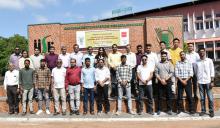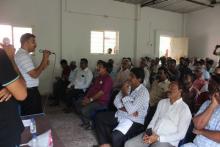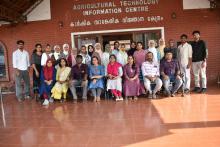
Specialization
Nematology
Total Publications
301
Qualification
Ph. D
Mobile
9447072747
Personal Email Id
Area of Interest:
Molecular characterization of nematodes, Biological control of nematodes, Bioinformatics, Knowledge management
Awards/Recognitions:
- Nematology consultant in Viet Nam, Food and Agriculture Organization (FAO), Rome
- Fellow - Indian Society for Spices
- Fellow - Nematological Society of India
- Research Guide - Singhania University, Rajasthan
- Research Guide - Mangalore University, Karnataka
- Research Guide - Kannur University, Kannur, Kerala
- Research Guide - Nagarjuna University, Guntur, Andhra Pradesh
- Research Guide - Calicut University
- Member, Executive Committee (Bioinformatics), JN Tropical Botanical Garden & Research Institute, Thiruvananthapuram
- Member - Board of Studies (Bioinformatics), University of Calicut, Kerala
- Member, Board of Studies - Zoology, St. Berchamans College, Changanacherry
- Examiner for PhD/ MSc examinations - UAS, Dharwad, Karnataka
- Examiner for PhD/ MSc examinations - University of Calicut, Kerala
- Guest faculty, Bioinformatics - NIT, Calicut
- Guest faculty, Bioinformatics - DOEACC Centre, Calicut
Research Papers
- Kumar A, Munjal V, Sheoran N, Prameela TP, Suseelabhai R, Aggarwal R, Jain RK, Eapen SJ 2017. Draft genome sequence of highly virulent race 4/biovar 3 of Ralstonia solanacearumCaRs_Mep causing bacterial wilt in Zingiberaceae plants in India. Genome Announcements 5:e01420-16. https://doi.org/10.1128/genomeA.01420-16.
- Prasath D, Eapen SJ and Sasikumar B 2016. Performance of turmeric (Curcuma longa) genotypes for yield and root-knot nematode resistance. Indian Journal of Agricultural Sciences 86 (9): 1189-92.
- Vibhuti M, Kumar A, Neelam S, Agisha VN, Eapen SJ 2016. Molecular basis of endophytic Bacillus megaterium-induced growth promotion in Arabidopsis thaliana: Revelation by microarray-based gene expression analysis. Journal of Plant Growth Regulation doi:10.1007/s00344-016-9624-z.
- Rosana OB, Eapen SJ, Krishna PB 2016. Cloning and characterization of genes encoding two detoxifying enzymes, glutathione s-transferase and carboxylesterase, from burrowing nematode (Radopholus similis). International Journal of Parasitology Research 8 (1): 173-183.
- Neelam S, Kumar A, Vibhuti M, Agisha VN, Eapen SJ 2016. Pseudomonas putida BP25 alters root phenotype and triggers salicylic acid signaling as a feedback loop in regulating endophytic colonization in Arabidopsis thaliana. Physiological and Molecular Plant Pathology 93: 99-111. doi:10.1016/j.pmpp.2016.01.008
- Johnson George K, Rosana OB, Vijesh Kumar IP, Eapen SJ, Anandaraj M 2016. Interplay of genes in plant-pathogen interactions: In planta expression and docking studies of a beta 1,3glucanase gene from Piper colubrinum and a glucanase inhibitor gene from Phytophthora capsici. Physiology and Molecular Biology of Plants 22: 567-573.
- Vibhuti M, Agisha V N, Neelam S, Aditi K, Vibina V, Subaharan K, Suseelabhai R, Eapen SJ, Kumar A 2015. Genotyping and identification of broad spectrum antimicrobial volatiles in black pepper root endophytic biocontrol agent, Bacillus megaterium BP17. Biological Control 92: 66-76. doi:10.1016/j.biocontrol.2015.09.005.
- Neelam S, Agisha VN, Vibhuti M, Aditi K, Subaharan K, Vibina V, Suseelabhai R, Eapen SJ, Kumar A 2015. Genetic analysis of plant endophytic Pseudomonas putida BP25 and chemo-profiling of its antimicrobial volatile organic compounds. Microbiological Research173: 66-78 doi:10.1016/j.micres.2015.02.001.
- Prasath D, Karthika R, Habeeba NT, Suraby EJ, Rosana OB, Shaji A, Eapen SJ, Deshpande U, Anandaraj M. 2014. Comparison of the transcriptomes of ginger (ZingiberofficinaleRosc.) and mango ginger (Curcuma amadaRoxb.) in response to the bacterial wilt infection. PLOS One 9(6): e99731. doi:10.1371/journal.pone.0099731.
- Kumar A, Munder A, Aravind R, Eapen SJ,Tummler B,Raaijmakers JM 2013. Friend or foe: genetic and functional characterization of plant endophyticPseudomonas aeruginosa. Environmental Microbiology 15 (3): 764-779.
- Pervez R, Eapen SJ, Devasahayam S, Jacob TK 2012. A new species of entomopathogenic nematode Oscheius gingeri sp. n. (Nematoda: Rhabditidae) from ginger rhizosphere. Archives of Phytopathology and Plant Protection 46: 526-535.
- Aravind R, Kumar A,Eapen SJ 2012. Pre-plant bacterisation: a strategy for delivery of beneficial endophytic bacteria and production of disease-free plantlets of black pepper (Piper nigrum L.). Archives of Phytopathology and Plant Protection 45: 1115-1126.
- Aravind R, Eapen SJ, Kumar A, Dinu A, Ramana KV 2010. Screening of endophytic bacteria and evaluation of selected isolates for suppression of burrowing nematode (Radopholus similis Thorne) using three varieties of black pepper (Piper nigrum L.). Crop Protection 29 (2010) 318-324.
- Aravind R, Kumar A, Eapen SJ, Ramana KV 2009. Endophytic bacterial flora in root and stem tissues of black pepper (Piper nigrum L.) genotype: isolation, identification and evaluation against Phytophthora capsici. Letters in Applied Microbiology 48: 58-64.
- Eapen SJ, Beena B, Ramana KV 2005. Tropical soil microflora of spice-based cropping systems as potential antagonists of root-knot nematodes. Journal of Invertebrate Pathology 88: 218-225.













